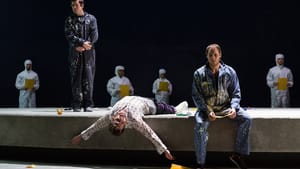Stay in the Loop
BSR publishes on a weekly schedule, with an email newsletter every Wednesday and Thursday morning. There’s no paywall, and subscribing is always free.
Having a blast
Curtis Institute presents John Adams and Peter Sellars's 'Doctor Atomic'

The Curtis Institute of Music’s revival of Doctor Atomic surpasses all performances of this opera I’ve seen before. My perspective is unique because I interviewed many of the atomic scientists at Los Alamos on the occasion of that project’s 50th anniversary.
When Doctor Atomic premiered in 2005, its Metropolitan Opera production was telecast on PBS and to movie houses worldwide. I believe its music is the greatest achievement in John Adams’s career. (The best-known of his other operas are Nixon in China and The Death of Klinghoffer.)
Bomb squad
Doctor Atomic follows Dr. J. Robert Oppenheimer, the scientific director of the A-bomb project. Peter Sellars’s libretto focuses on the days preceding the first atomic-bomb explosion in July 1945 in New Mexico. Other principal characters are physicist Edward Teller; the project’s commanding general, Leslie Groves; and Oppenheimer’s wife, Kitty.
Earlier productions tried to be literal; this one did not, and that’s what made it better. Previous stagings showed each character holding a sign with a picture of their real-life parallel, and singers were cast for their resemblance to those people. For this production, director R.B. Schlather chose stocky Jonathan McCullough to portray the famously skinny, frail Oppenheimer and blonde Siena Licht Miller for the role of Kitty, whose hair (as the libretto specifically mentions) was dark.
Because the original production had a documentary tone, I was irritated by Sellars’s tilting of the content. For dramatic reasons or because of personal bias, he portrayed great angst about the morality of using such a weapon. Actually, almost all of the men at that time were enthusiastically in favor of making a weapon that could shorten the war, just as the American public was joyous about its use. Their anxieties were mainly that their bomb might be a dud — three years’ work that could end in failure. (Some physicists, like Leo Szilard, had reservations and declined to participate in the project. Sellars’s script places Szilard in Los Alamos.)
A reversal of opinion did occur after the end of the war, and Oppenheimer voiced regrets. After Hiroshima, however, Oppenheimer celebrated and clasped his hands above his head like a fighter who'd just won a championship. Now, with this fanciful, atmospheric staging, we can embrace the central theme of wrestling with one's conscience about moral choices and set aside our concerns about its factual correctness. Schlather used a bare graphite-grey rectangular stage topped with a round platform of the same color. The physicists wore hazmat suits and masks, while Oppenheimer wore a bright-orange jumpsuit, conveying the idea of grave danger and of Oppenheimer’s eccentric personality.
Flights of fantasy
Oppenheimer was a warm, embracing man, but even his best friend said he was an intellectual snob who liked to quote, by memory, from Charles Baudelaire, John Donne, and the Bhagavad Gita. He called the test site Trinity, based on Donne’s sonnet “Batter my heart, three-person’d God.” Its words are used in a great dramatic aria that closes the first act. McCullough sang it passionately, accompanied by pounding rhythmic chords from the orchestra. The libretto relies heavily on poetry and the esoteric musings of both Kitty and a Native American mother. This slows down the opera, but Adams’s music — throbbing, clashing, inspiring — makes those long stretches interesting.
This production had no set pieces and made no attempt to replicate the laboratory or test site, allowing Adams’s brooding, relentless music to shape our feelings. As McCullough sang, he leapt upward, as if grasping for an understanding of the universe. At other times he twisted and somersaulted, demonstrating his conflicted emotions.
Baritone Tyler Zimmerman’s Edward Teller displayed nervous tics (fictional) and maniacal giggles when singing about the weapon’s huge power, giving him a resemblance to Mephistopheles. Teller later invented the hydrogen bomb, a weapon many times more powerful than those used in 1945. Another innovation here was presenting Kitty Oppenheimer’s sexuality. When she presses her body against Robert’s, he pushes her away, indicating his greater passion for the work of producing the bomb.
The 32 chorus members moved in consonance with the music, rather than trying to imitate occupational comings and goings. We saw mythology, comparable to Wagner’s Ring of the Nibelungen. Curtis’s orchestra, led by Timothy Myers, played Adams’s score magnificently. Additional powerful singing came from Vartan Gabrielian as General Groves, Evan LeRoy Johnson as Robert Wilson, and Sophia Fiuza Hunt as Pasqualita.
To read Steve Cohen's 2008 review of this opera, click here.
What, When, Where
Doctor Atomic. Music by John Adams; libretto by Peter Sellars; R. B. Schlather directed; Timothy Myers conducted. Curtis Institute of Music Opera Theatre. March 2-4, 2017, at the Kimmel Center's Perelman Theater, 300 S. Broad Street, Philadelphia. (215) 893-7902 or curtis.edu.
Sign up for our newsletter
All of the week's new articles, all in one place. Sign up for the free weekly BSR newsletters, and don't miss a conversation.

 Steve Cohen
Steve Cohen